
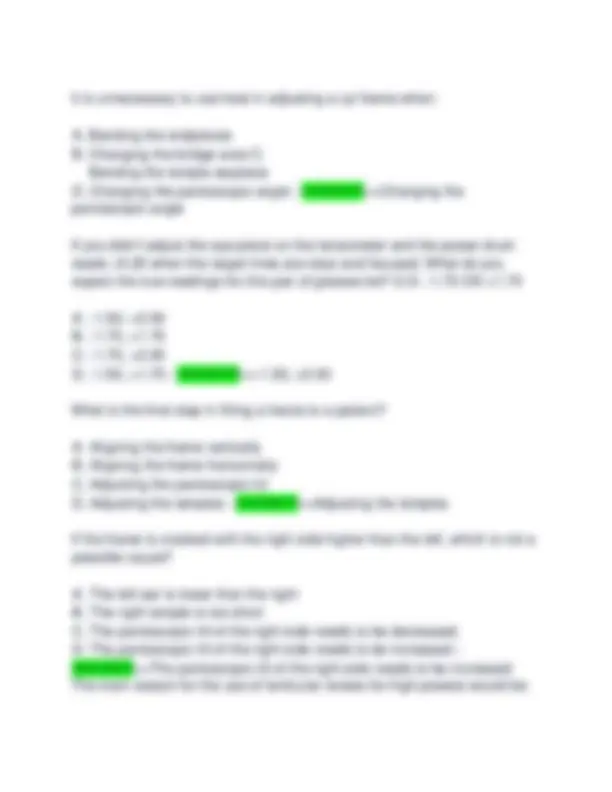
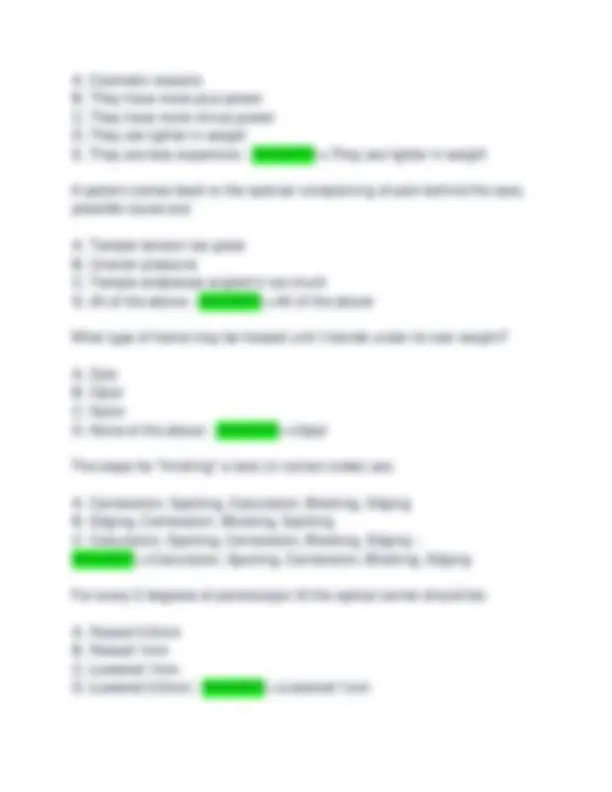
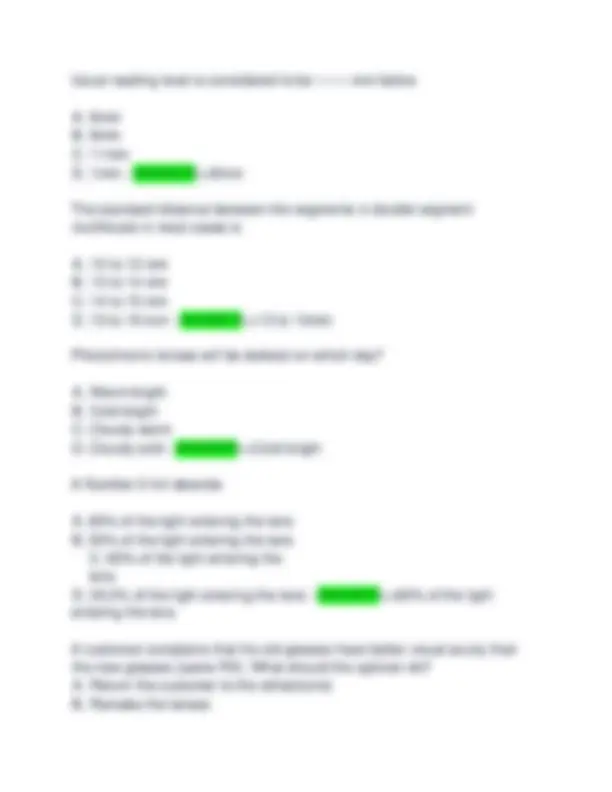
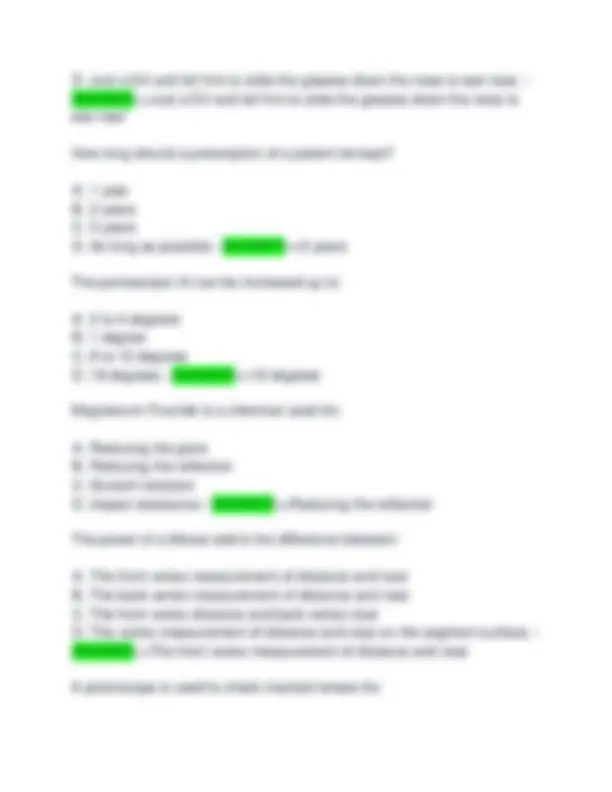
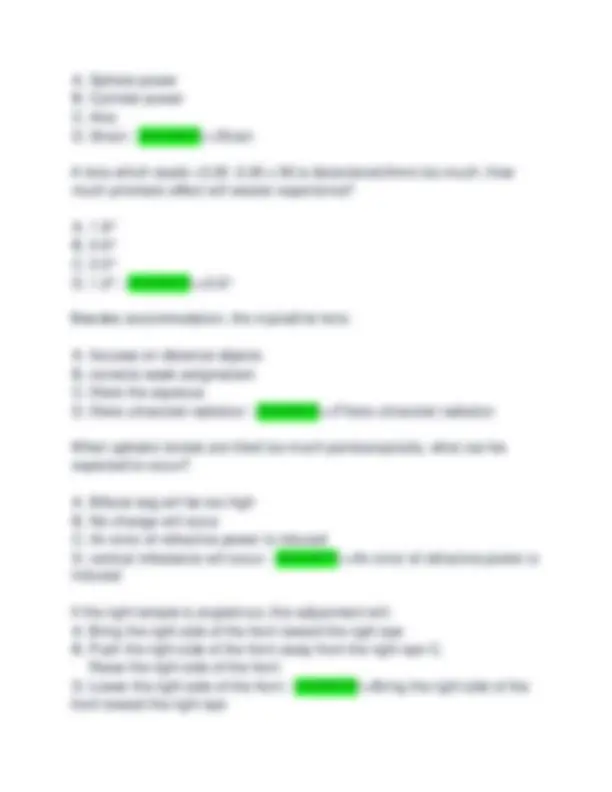
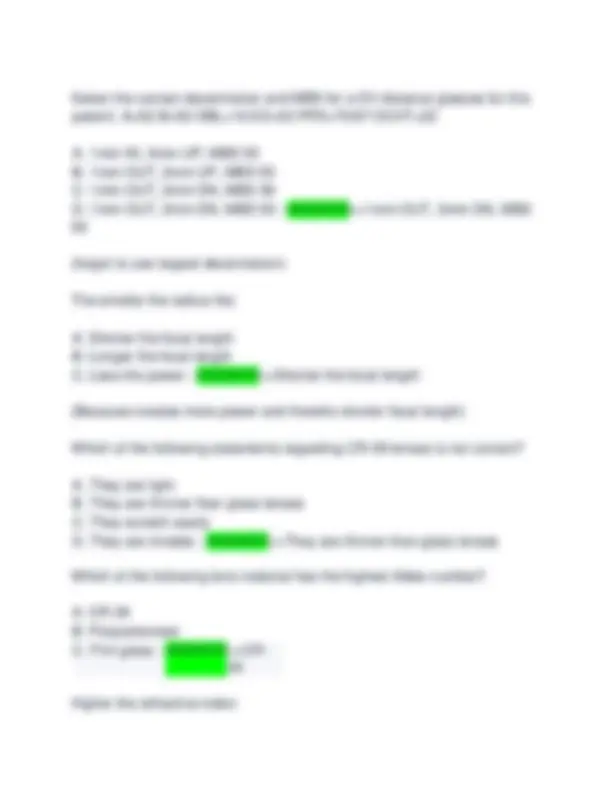
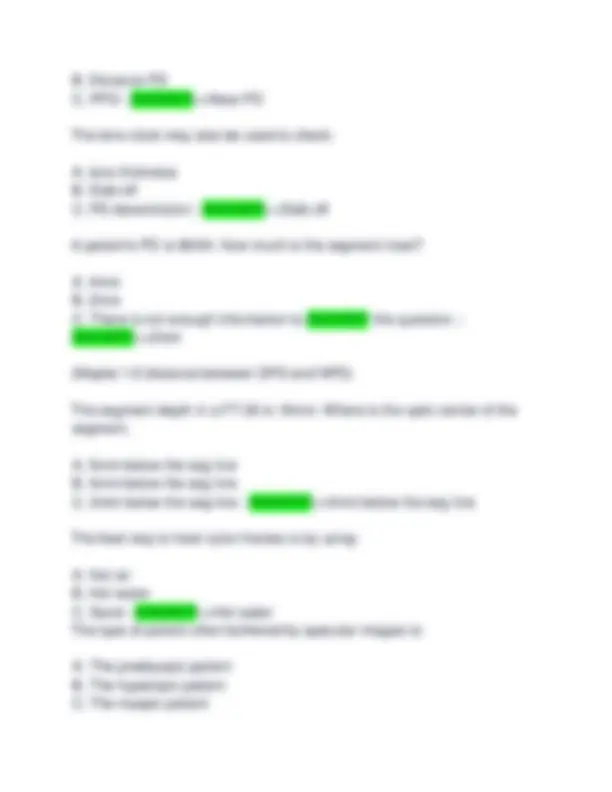
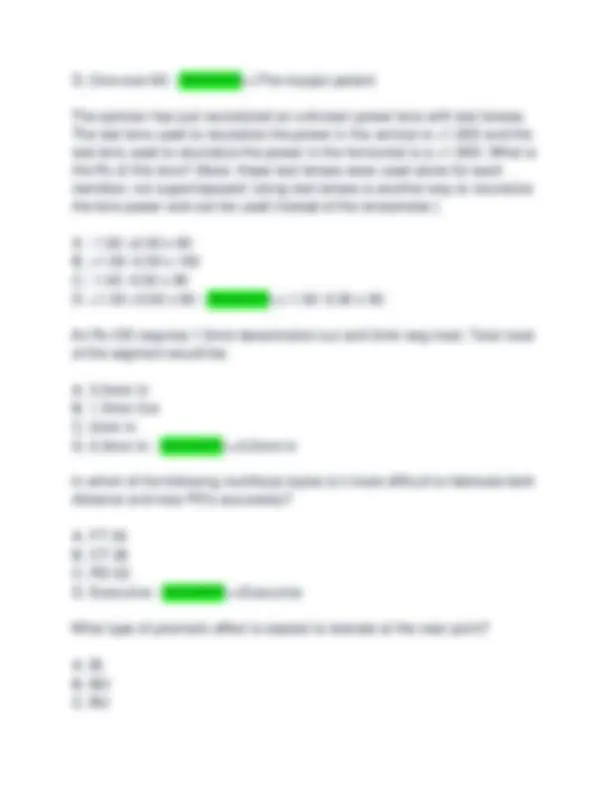
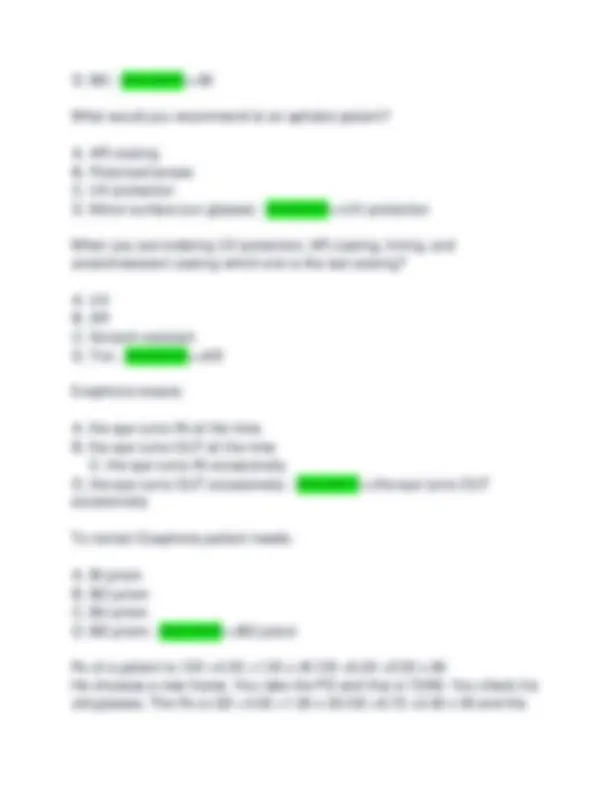
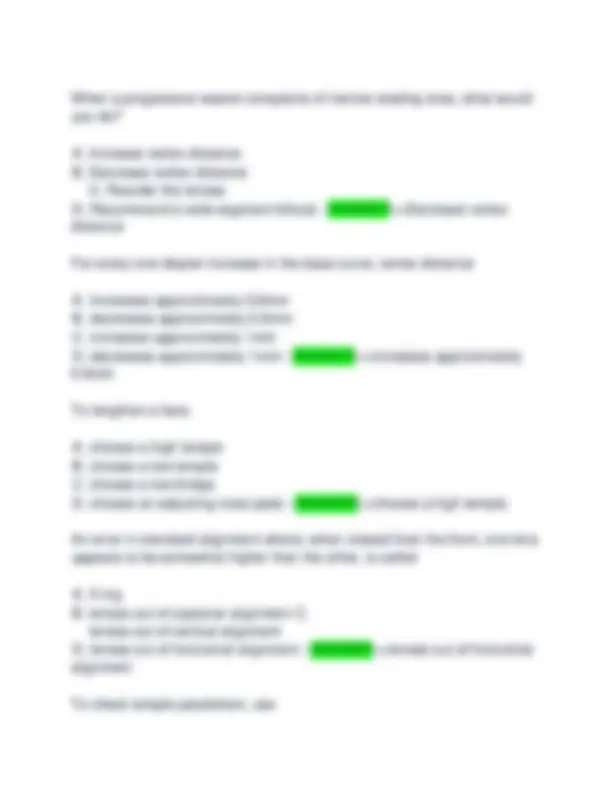
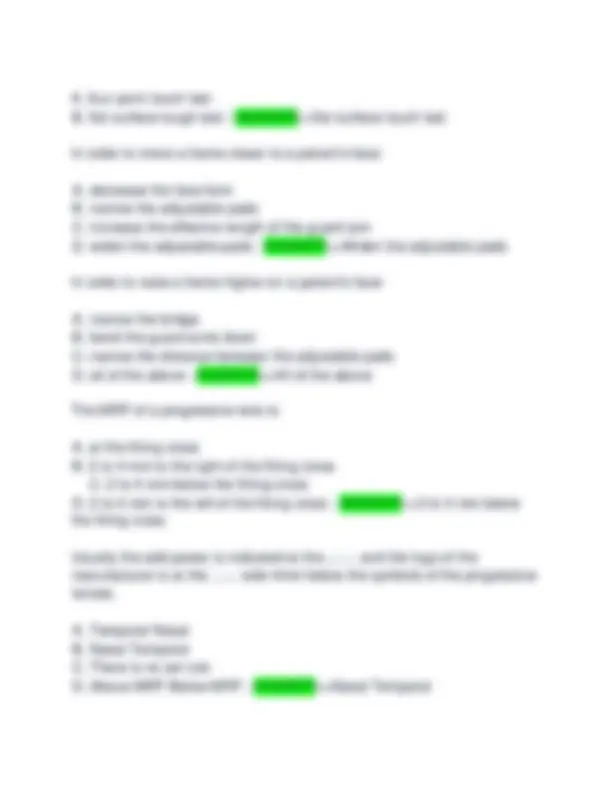
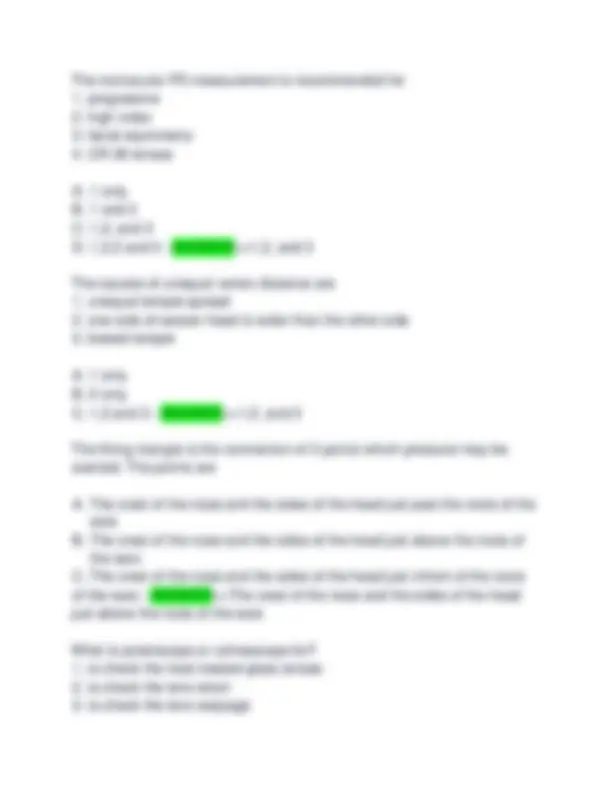
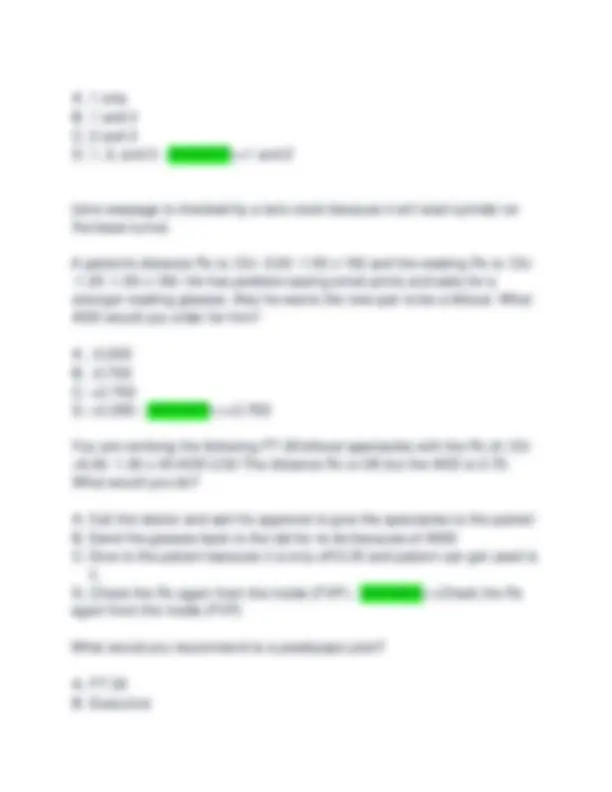
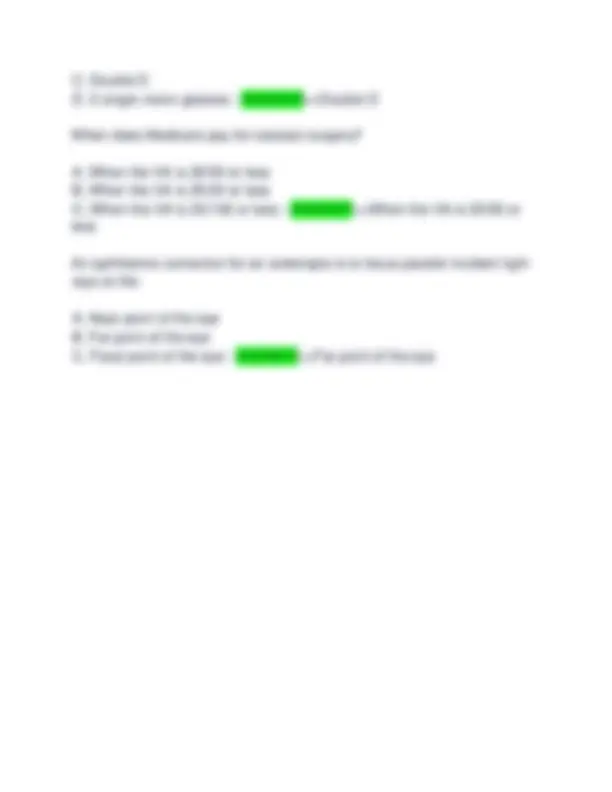


Study with the several resources on Docsity

Earn points by helping other students or get them with a premium plan


Prepare for your exams
Study with the several resources on Docsity

Earn points to download
Earn points by helping other students or get them with a premium plan
Community
Ask the community for help and clear up your study doubts
Discover the best universities in your country according to Docsity users
Free resources
Download our free guides on studying techniques, anxiety management strategies, and thesis advice from Docsity tutors
ABO practice exam 2024-2025 QUESTION AND ANSWERS If the wearer complains of the bifocal line being somewhat in his way when driving, the problem may be alleviated by decreasing the distance between pads. True or False - ANSWER >>False If the wearer complains that the glasses feel snug but still slip down the nose, one likely cause is that: A. The frame is too small B. The bridge fit is tight C. Pressure is being applied by the temple shafts anterior to the ear. D. Pressure is being applied on the very tips of the temples. - ANSWER >>Pressure is being applied by the temple shafts anterior to the ear If both nosepads press the nose or indent too much, what is probably not a possible cause? A. Pads too small for frame weight B. Temple spread is not even C. Pads too close together D. Temple tension too great - ANSWER >>Temple spread is not even
Typology: Exams
1 / 22

This page cannot be seen from the preview
Don't miss anything!















If the wearer complains of the bifocal line being somewhat in his way when driving, the problem may be alleviated by decreasing the distance between pads. True or False - ANSWER>>False If the wearer complains that the glasses feel snug but still slip down the nose, one likely cause is that: A. The frame is too small B. The bridge fit is tight C. Pressure is being applied by the temple shafts anterior to the ear. D. Pressure is being applied on the very tips of the temples. - ANSWER>>Pressure is being applied by the temple shafts anterior to the ear If both nosepads press the nose or indent too much, what is probably not a possible cause? A. Pads too small for frame weight B. Temple spread is not even C. Pads too close together D. Temple tension too great - ANSWER>>Temple spread is not even To eliminate a gap between the lens and a metal eyewire, the best alternative is to: A. Place a strip of lens liner at a point exactly opposite the gap B. Place a strip of lens liner in the gap area C. Heat the lens in the frame and allow it to cool at room temperature D. None of the above methods are satisfactory E. All of the above methods are satisfactory - ANSWER>>Place a strip of lens liner at a point exactly opposite the gap
The larger the frame difference --------- the lens shape A. Rounder B. More squared off C. Narrower D. Wider - ANSWER>>Narrower (Frame Difference=A-B) Which is the most favorable alternative to a 50/20 frame for measuring bifocal height when that particular size is not available? A. 52/ B. 50/ C. 48/ D. 50/22 - ANSWER>>48/ (would want bridge to stay the same) When the frame front is tested for four point tough, but only touches on the two temporal sides, the frame -------- A. is skewed B. has face form C. is out of coplanar alignment D. has X ing E. none of the above - ANSWER>>Has face form Which of the following errors will not be detected by a four point touch test? A. X-ing B. Excess face form C. Skewing D. All of the above can be detected using a four point touch - ANSWER>>Skewing
A. Cosmetic reasons B. They have more plus power C. They have more minus power D. They are lighter in weight E. They are less expensive - ANSWER>>They are lighter in weight A patient comes back to the optician complaining of pain behind the ears, possible cause are: A. Temple tension too great B. Uneven pressure C. Temple endpieces angled in too much D. All of the above - ANSWER>>All of the above What type of frame may be heated until it bends under its own weight? A. Zyle B. Optyl C. Nylon D. None of the above - ANSWER>>Optyl The steps for "finishing" a lens (in correct order) are: A. Centeration, Spotting, Calculation, Blocking, Edging B. Edging, Centeration, Blocking, Spotting C. Calculation, Spotting, Centeration, Blocking, Edging - ANSWER>>Calculation, Spotting, Centeration, Blocking, Edging For every 2 degrees of pantoscopic tilt the optical center should be: A. Raised 0.5mm B. Raised 1mm C. Lowered 1mm D. Lowered 0.5mm - ANSWER>>Lowered 1mm
Usual reading level is considered to be ------- mm below A. 6mm B. 8mm C. 11mm D. 1mm - ANSWER>>8mm The standard distance between the segments in double segment multifocals in most cases is A. 10 to 12 mm B. 13 to 14 mm C. 14 to 15 mm D. 15 to 16 mm - ANSWER>>13 to 14mm Photochronic lenses will be darkest on which day? A. Warm bright B. Cold bright C. Cloudy warm D. Cloudy cold - ANSWER>>Cold bright A Number 3 tint absorbs A. 80% of the light entering the lens B. 50% of the light entering the lens C. 60% of the light entering the lens D. 33.3% of the light entering the lens - ANSWER>>80% of the light entering the lens A customer complains that his old glasses have better visual acuity than the new glasses (same RX). What should the optician do? A. Return the customer to the refractionist B. Remake the lenses
B. 1 and 3 C. 1,3, and 4 D. 1,2,3, and 4 - ANSWER>>1,3, and 4 Rx: OD - 4.50 4BD OD - 5.00 2BO Which of the following is a usual way of ordering the lenses? A. OU - 4.50 4BD and 2BO B. OD - 4.50 2BD 1BO OS - 5.00 2BU 1BO C. OD - 4.50 4BD OS - 5.00 2BO D. OD - 4.50 2BD 1BO OS - 5.00 2BD 1BO - ANSWER>>OD - 4.50 2BD 1BO OS - 5.00 2BU 1BO Which of the following is recommended for children's bridge? A. Saddle B. Keyhole C. Adjustable pads D. Golden gate - ANSWER>>Keyhole A frame fits perfectly on your patient. The temples, bridge, and pads are fine, but the frame sits high. You should select a frame with a bridge that is: A. Wider B. Narrower C. Higher D. Lower - ANSWER>>Wider OU +11.00 - 1.00 x 90 ADD 3. This is an aphakic patient. He wants a separate sunglasses just for golf. What would you recommend? A. a low fitting FT 28 B. RD segment high fitted C. A trifocal
D. Just a SV and tell him to slide the glasses down the nose to see near. - ANSWER>>Just a SV and tell him to slide the glasses down the nose to see near How long should a prescription of a patient be kept? A. 1 year B. 2 years C. 3 years D. As long as possible - ANSWER>>3 years The pantoscopic tilt can be increased up to: A. 2 to 4 degrees B. 1 degree C. 8 to 10 degrees D. 18 degrees - ANSWER>>18 degrees Magnesium Fluoride is a chemical used for: A. Reducing the glare B. Reducing the reflection C. Scratch resistant D. Impact resistance - ANSWER>>Reducing the reflection The power of a bifocal add is the difference between: A. The front vertex measurement of distance and near B. The back vertex measurement of distance and near C. The front vertex distance and back vertex near D. The vertex measurement of distance and near on the segment surface. - ANSWER>>The front vertex measurement of distance and near A polariscope is used to check inserted lenses for:
Select the correct decentration and MBS for a SV distance glasses for this patient. A=52 B=50 DBL=16 ED=53 PPD=70/67 OCHT= A. 1mm IN, 3mm UP, MBS 55 B. 1mm OUT, 3mm UP, MBS 55 C. 1mm OUT, 3mm DN, MBS 59 D. 1mm OUT, 3mm DN, MBS 55 - ANSWER>>1mm OUT, 3mm DN, MBS 59 (forgot to use largest decentration) The smaller the radius the: A. Shorter the focal length B. Longer the focal length C. Less the power - ANSWER>>Shorter the focal length (Because creates more power and therefor shorter focal length) Which of the following statements regarding CR-39 lenses is not correct? A. They are light B. They are thinner than glass lenses C. They scratch easily D. They are tintable - ANSWER>>They are thinner than glass lenses Which of the following lens material has the highest Abbe number? A. CR- 39 B. Polycarbonate C. Flint glass - ANSWER>>CR- 39 Higher the refractive index:
A. The better the absorption of uv radiation B. The worse the absorption of UV radiation C. None of the above - ANSWER>>The better the absorption of UV radiation What base curve is suitable for this Rx: - 4.00 - 1.00 x 90? A. +2.00D B. +5.00D C. Plano D. +8.00D - ANSWER>>+8.00D What base curve do you recommend for this Rx:
B. Distance PD C. PPD - ANSWER>>Near PD The lens clock may also be used to check: A. lens thickness B. Slab off C. PD decentration - ANSWER>>Slab off A patient's PD is 68/64. How much is the segment inset? A. 4mm B. 2mm C. There is not enough information to ANSWER this question. - ANSWER>>2mm (Maybe 1/2 distance between DPD and NPD) The segment depth in a FT 28 is 18mm. Where is the optic center of the segment. A. 5mm below the seg line B. 4mm below the seg line C. 2mm below the seg line - ANSWER>>4mm below the seg line The best way to heat nylon frames is by using: A. Hot air B. Hot water C. Sand - ANSWER>>Hot water The type of patient often bothered by specular images is: A. The presbyopic patient B. The hyperopic patient C. The myopic patient
D. One over 65 - ANSWER>>The myopic patient The optician has just neutralized an unknown power lens with test lenses. The test lens used to neutralize the power in the vertical is +1.00D and the test lens used to neutralize the power in the horizontal is a +1.50D. What is the Rx of this lens? (Note: these test lenses were used alone for each meridian, not superimposed. Using test lenses is another way to neutralize the lens power and can be used instead of the lensometer.) A. - 1.50 +0.50 x 90 B. +1.50 - 0.50 x 180 C. - 1.00 - 0.50 x 90 D. +1.00 +0.50 x 90 - ANSWER>>-1.00 - 0.50 x 90 An Rx OD requires 1.5mm decentration out and 2mm seg inset. Total inset of the segment would be: A. 3.5mm In B. 1.5mm Out C. 2mm In D. 0.5mm In - ANSWER>>0.5mm In In which of the following multifocal styles is it more difficult to fabricate both distance and near PD's accurately? A. FT 35 B. CT 28 C. RD 22 D. Executive - ANSWER>>Executive What type of prismatic effect is easiest to tolerate at the near point? A. BI B. BO C. BU
MPD is 65. There is no mention of PPD in the new Rx and the patient has no complain. What would you do? A. Fill up the order form with the new PD (72) and order the lenses B. Tell the patient to come back another day for checking the PD C. Fill up the order form with the previous PD (65) and order the lenses - ANSWER>>Fill up the order form with the previous PD (65) and order the lenses Rx: OD +2.00 +4.00 x 45 OS +3.00 +1.00 x 90 A=52 DBL=18 PPD= The lab decenters the lenses the wrong way. The prism imbalance will be: A. 1.6 prism diopter B. 3.2 prism diopter C. 1 prism diopter D. 2 prism diopter - ANSWER>>3.2 diopter A patient's best point of focus is 10". What lens would he need to see 20/20? A. - 10.00D B. +4.00D C. - 2.00D D. - 4.00D - ANSWER>>-4.00D D=1/0.254m=3.94---4.00D How many recti muscles do we have? A. 4 B. 6 C. 2 D. None - ANSWER>>
A 5 years old walks to your optical dispensary. You notice that when he wants to look to the frames his right eye turns in. What is the problem? A. He has exophoria B. He has esophoria C. He has exotropia D. He has esotropia - ANSWER>>He has esophoria A patient brings the following Rx to you. What would you do? Rx: OD - 2.00 - 1.00 x 180 OS - 1.00 +1.00 x 180 A. After transposing the OS, you order the lenses B. After transposing the OD, you order the lenses C. You order the lenses the way they are. D. You will call the refractionist - ANSWER>>You will call the refractionist Which of the following frame material should be soaked overnight periodically? A. Optyl B. Polyamide C. Nylon - ANSWER>>Nylon A frame material which is excellent for people with an active lifestyle because of its flexibility and impact resistance; A. Cellulose acetate B. Titanium C. Nylon - ANSWER>>Nylon This frame material shrinks as heat is applied; A. Polyamide B. Optyl C. Cellulose acetate - ANSWER>>Polyamide
A. four point touch test B. flat surface tough test - ANSWER>>flat surface touch test In order to move a frame closer to a patient's face: A. decrease the face form B. narrow the adjustable pads C. increase the effective length of the guard arm D. widen the adjustable pads - ANSWER>>Widen the adjustable pads In order to raise a frame higher on a patient's face: A. narrow the bridge B. bend the guard arms down C. narrow the distance between the adjustable pads D. all of the above - ANSWER>>All of the above The MRP of a progressive lens is: A. at the fitting cross B. 2 to 4 mm to the right of the fitting cross C. 2 to 4 mm below the fitting cross D. 2 to 4 mm to the left of the fitting cross - ANSWER>>2 to 4 mm below the fitting cross Usually the add power is indicated at the......... and the logo of the manufacturer is at the ....... side 4mm below the symbols of the progressive lenses. A. Temporal Nasal B. Nasal Temporal C. There is no set rule D. Above MRP Below MRP - ANSWER>>Nasal Temporal
The monocular PD measurement is recommended for